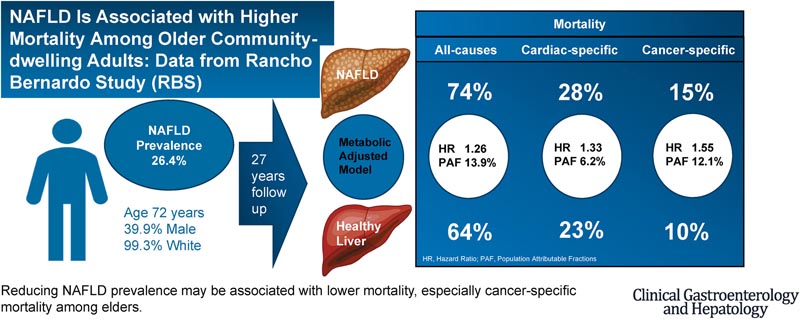Nonalcoholic fatty liver disease is independently associated with increased all-cause and cause-specific mortality

Background and objectives
The prevalence of nonalcoholic fatty liver disease (NAFLD) is increasing globally. We evaluated the independent associations of NAFLD with all-cause and cause-specific mortality in community-dwelling older adults in the United States.
Methods
Data were analyzed from the Rancho Bernardo Study cohort, which participated in the research from 1992 to 1996 with mortality data (follow-up until July 2019).
NAFLD was determined using the improved fatty liver index for the US multiethnic population in the absence of secondary causes of liver disease.
Hazard ratios (HRs), 95% CIs, and population-attributable fractions of risk factors on mortality were calculated. Competing risk analyzes of cause-specific mortality were performed.
Results
Of the 1,523 eligible participants (mean age, 71.8 years; 39.9% male; 99.3% non-Hispanic white; and 10.7% obese), 404 (26.4%) had NAFLD.
During 23,311 person-years of follow-up evaluation (mean, 15.22 years; SD, 8.41 years), among NAFLD and non-NAFLD, there were 296 and 717 all-cause deaths, 113 and 263 cardiac deaths, 62 and 112 cancer deaths and 6 and 2 liver deaths, respectively.
NAFLD had a 26% higher (HR, 1.26; 95% CI, 1.08–1.47) and 33% higher (HR, 1.33; 95% CI, 1.04) all-cause mortality. –1.70) and 55% (HR, 1.55; 95% CI, 1.11–2.15) higher cardiac and cancer mortality, respectively, than non-NAFLD.
The fractions attributable to the population showed 13.9% of deaths, 6.2% of cardiac deaths and 12.
Conclusions NAFLD is independently associated with all-cause, cardiac, and cancer mortality. Efforts should continue to raise awareness of NAFLD and develop care pathways and public health efforts to reduce the burden of NAFLD and associated mortality. |















